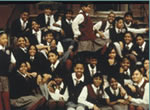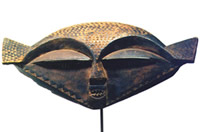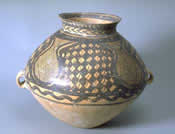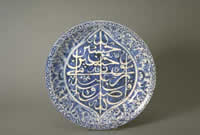| |
||
 |
||
| |
|
|
| |
|
|
|
|
|
|
|
|
|
|
|
|
|
|
|
|
|
|
|
|
|
|
|
|
|
|
|
|
| |
|
| |
| Local
Attractions
The University Musical Society
On Saturday, April 17, the University Musical Society has its annual dance party at the Eastern Michigan University Convocation Center with a performance of Orchestra Baobab at 9:00 p.m. Visit www.ums.org
for more details about tickets and these programs. Masterworks of African Art Masterworks of African Art will explore the aesthetic and visual power of African art made by peoples along the Congo River Basin. Guest curated by Michael Kan, former Curator of African Art at the Detroit Institute of Arts, the project is the first of three exhibitions devoted to exploring several different regions of the African continent. Drawn from private collections in the region and those of University of Michigan alumni, the works on view have all been chosen for their exemplary aesthetic qualities. The exhibition provides a rare opportunity to see works not frequently available to the public and to explore the uses and ritual roles of these art objects in their cultural settings.
Since the very beginnings of Chinese civilization, one of its identifying characteristics has been a concern with the welfare of the dead. This exhibition traces evolving customs of burial across four millennia and reveals major shifts in political, social, and religious history. The most beautiful artifacts of the Neolithic Yangshao culture of northwest China (circa 2600–2300 BCE) were designed for burial—magnificent hand-built clay pots, painted with bold patterns, which held grain and were buried in shallow graves. The Bronze Age (17th–3rd centuries BCE) brought sharp social stratification, and tombs of the elite contained vast numbers of finely cast bronze weapons, food and wine vessels, or personal accoutrements. Royal burials frequently included human and animal sacrifices as well, to provide an eternal entourage for the deceased. The Han period (2nd century BCE–2nd century CE) saw the rise of two conflicting trends: a new cult of immortality inspired visionary images of heaven, while a new practicality led to the substitution of clay models for humans, animals, and precious materials in tomb furnishings. Artists reveled in creating realistic if miniature replicas of daily life. This practice continued through the 9th century but then fell out of fashion as cremation became more common with the widespread adoption of Buddhism. Chinese of the Song period (10th–12th centuries) used exquisite celadon jars adorned with paradise imagery in their funerary rites. Consistent across all these centuries is the belief that the dead are not gone; as society changed, so did ideas about how to keep the dead content. (Maribeth Graybill, Senior Curator of Asian Art)
The Islamic art in the Museum collection is well known to scholars throughout the world, but may be much less familiar to regular Museum visitors. That irony should now be remedied by the creation of new cases adjacent to the Chinese Gallery on the second floor, specially designed to house rotating displays of UMMA’s finest works of ceramics, metalwork, calligraphy and painting from the classical Islamic civilizations of North Africa and the Middle East. In an exciting example of the Museum’s effort to integrate its projects with the University’s teaching mission, the inaugural display is curated by undergraduate students in a course on Islamic Art, under the direction of Professor Sussan Babaie of the History of Art Department. Art of the Islamic world is characterized by a love of ornament: sinuous lines of Arabic calligraphy and floral or geometric motifs (“arabesques”) adorn the surface of objects large and small. Yet there is also astonishing variety across time, space, and differences of function. One of the oldest works in the exhibition is a ninth- or tenth-century page from the Qu’ran, written in the austere Kufic or priestly script; at the opposite extreme are the jewel-like illustrations of romantic heroes and flowery gardens in a fifteenth-century manuscript of the Shah Nama or “Book of Kings,” the national epic of Iran, produced for the Persian court. The display also includes magnificent examples of inlaid metalwork and lustreware ceramics, two media at which Islamic artists excelled. (Maribeth Graybill, Senior Curator of Asian
Art) |




